Communication in Organizations© Copyright 2003, Prentice Hall 2




















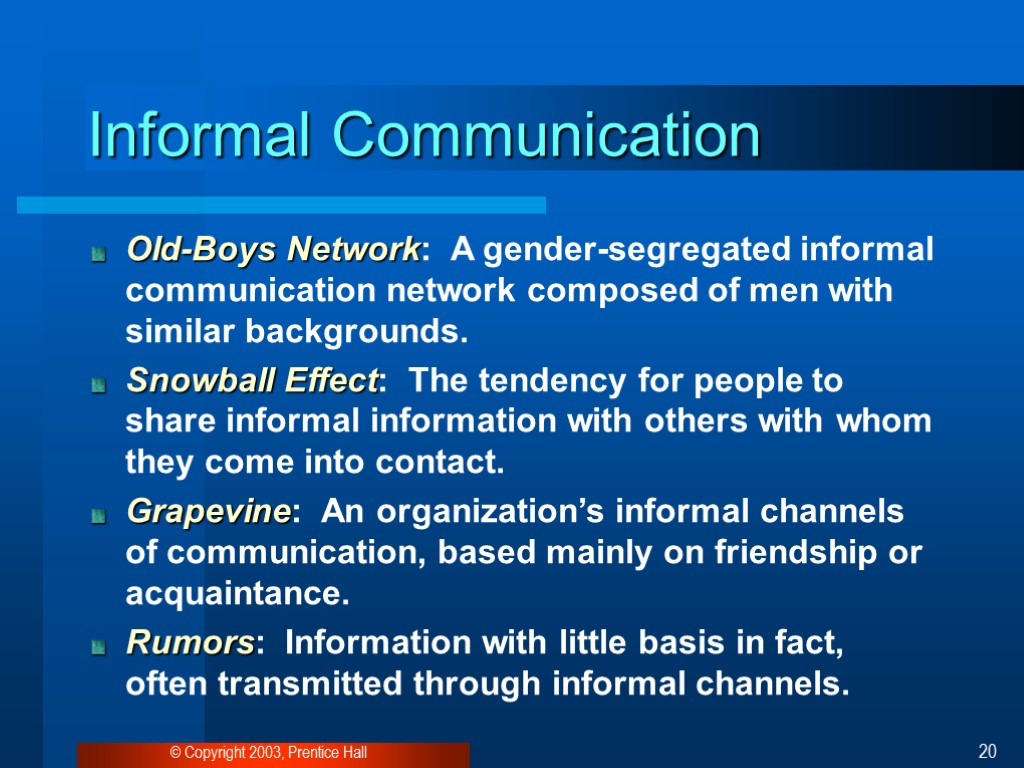



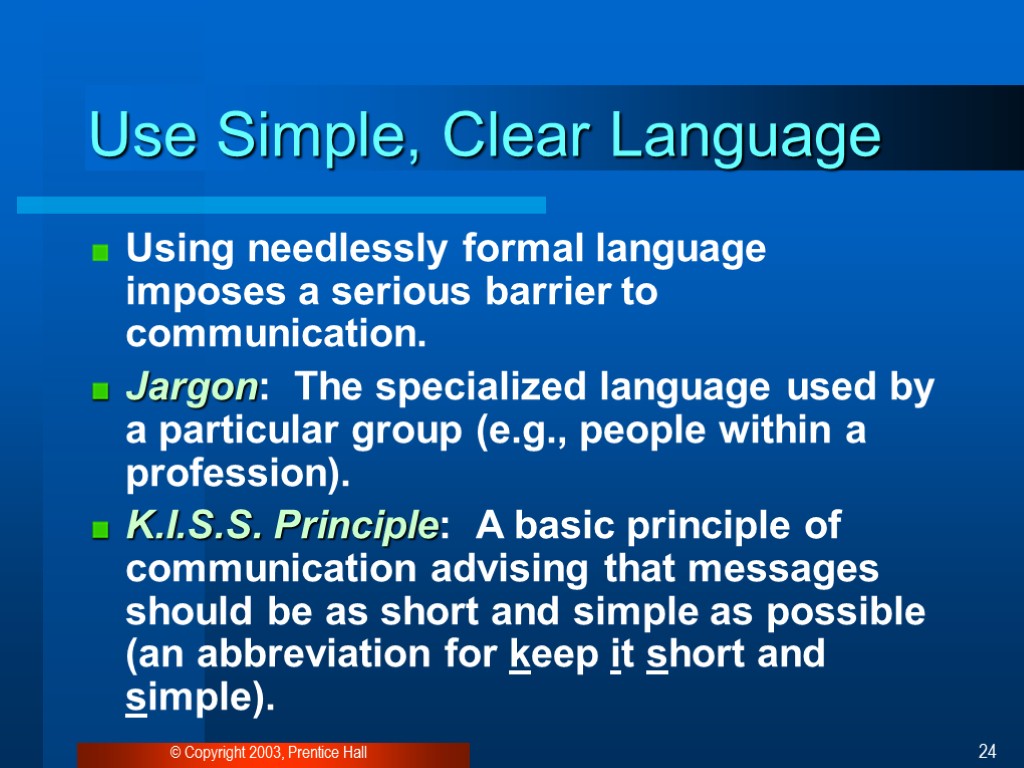

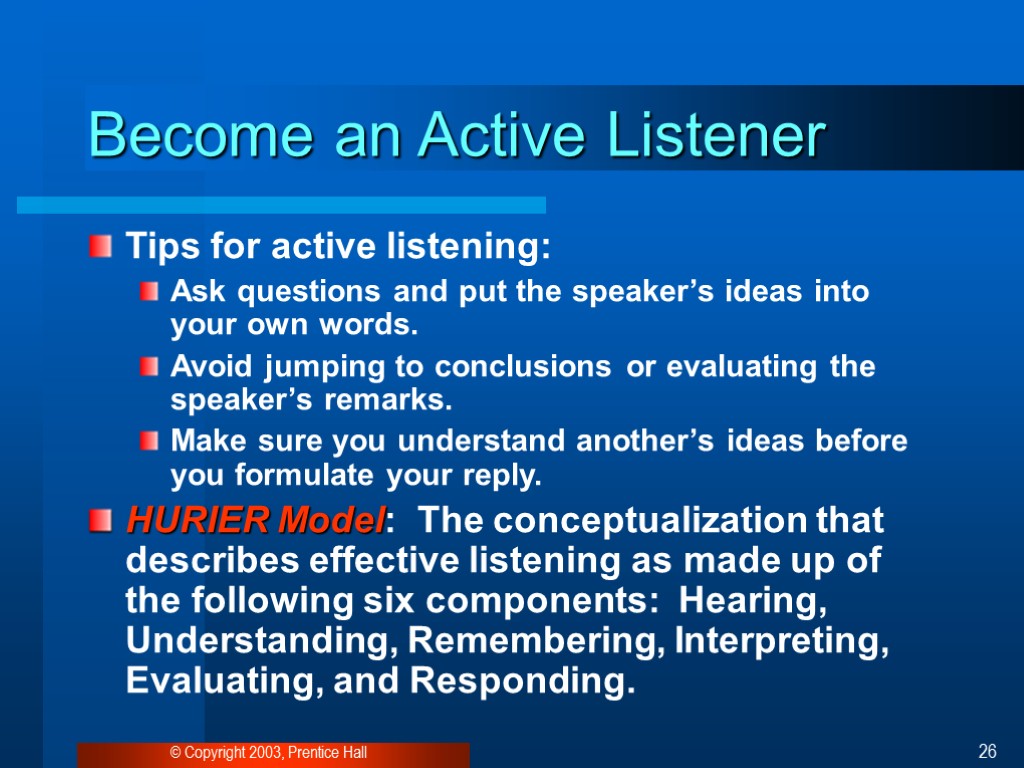
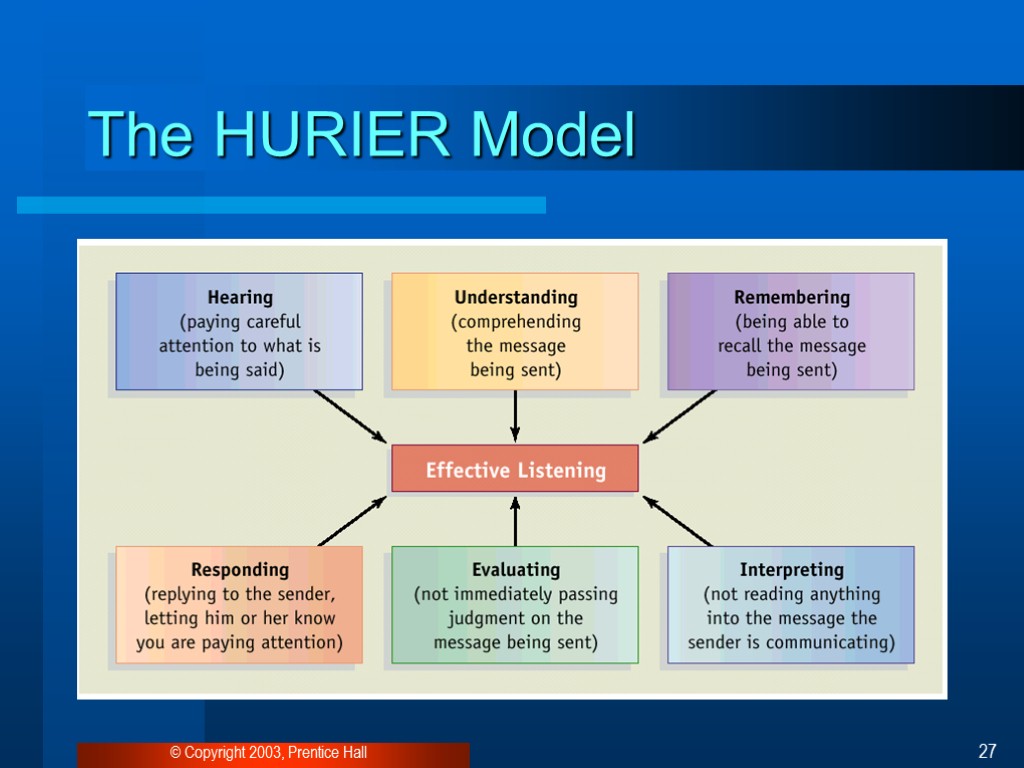
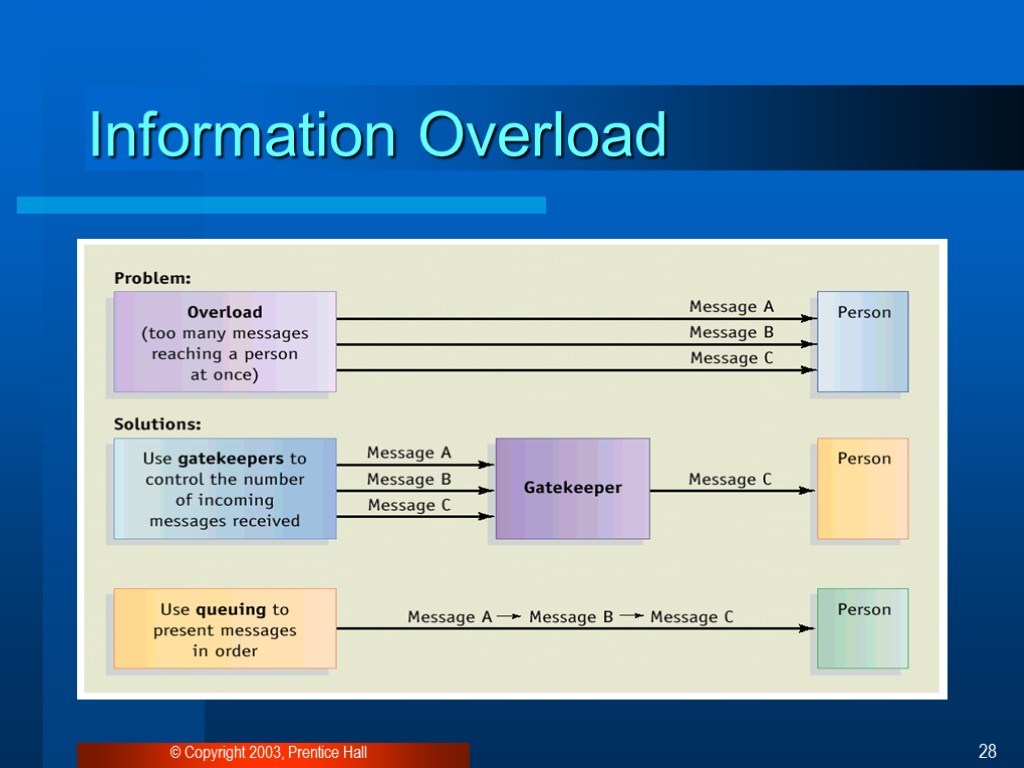
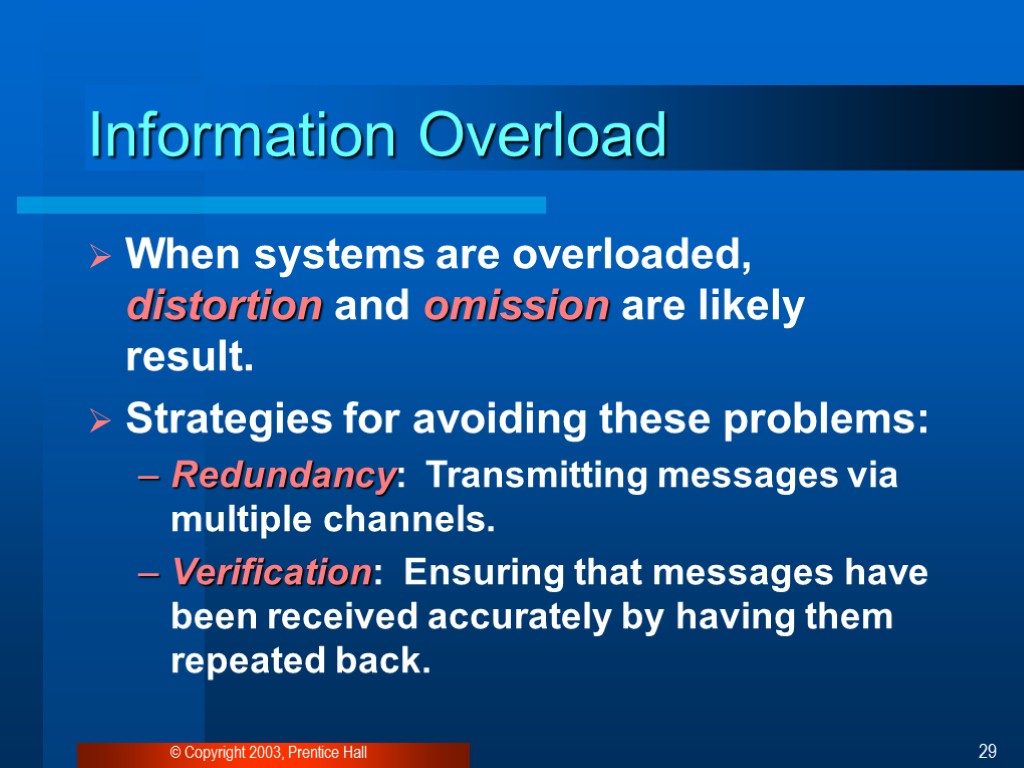
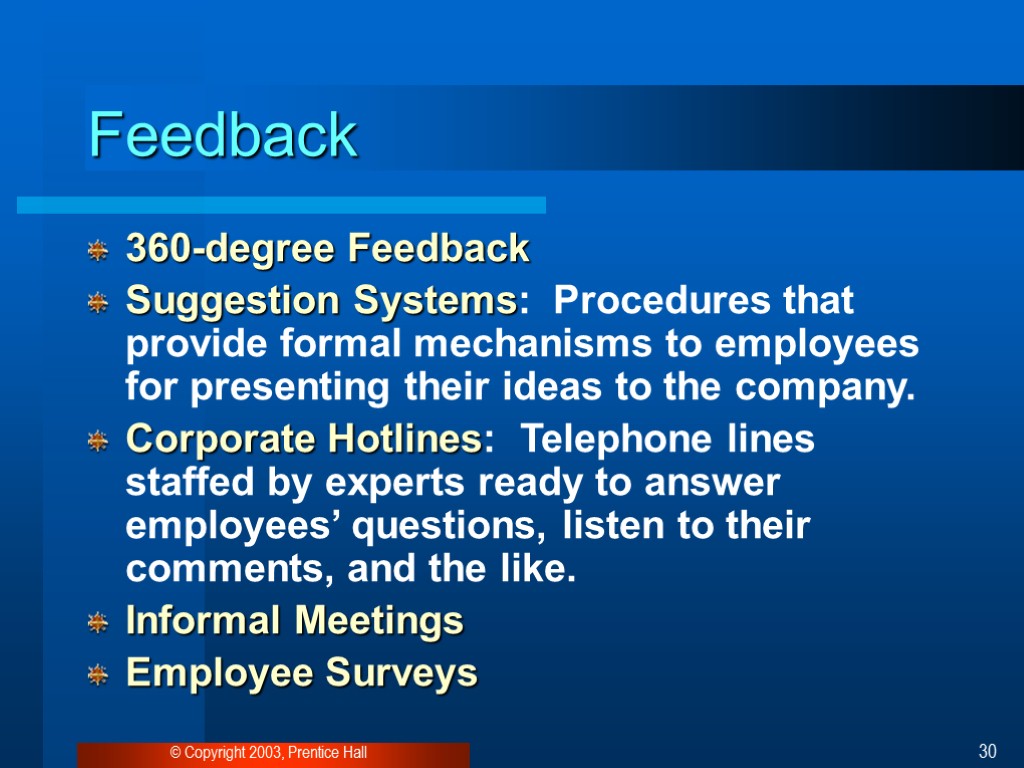
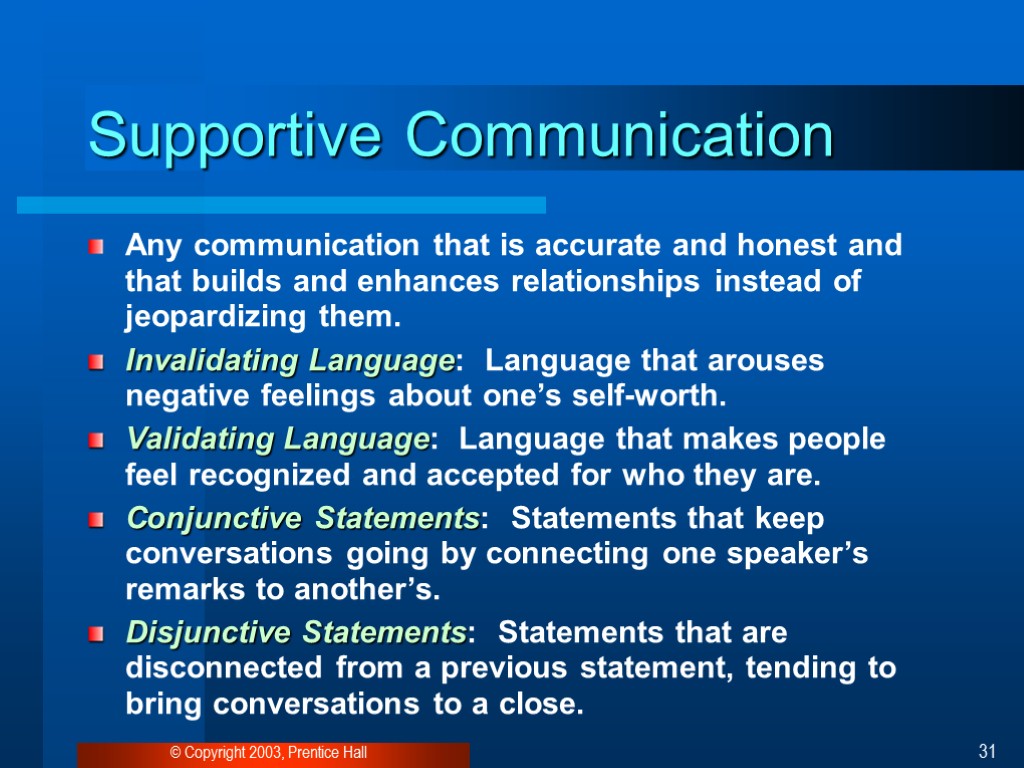
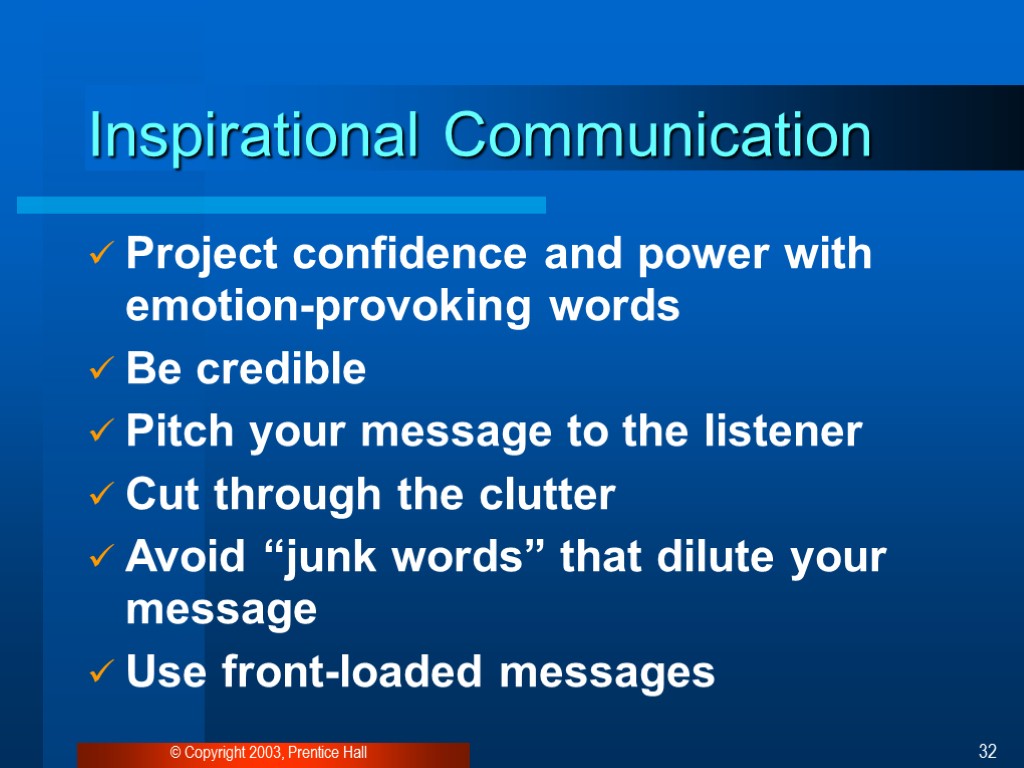

lecture1a_1bc_core_concepts_communication.ppt
- Количество слайдов: 33
 Communication in Organizations
Communication in Organizations
 © Copyright 2003, Prentice Hall 2 Learning Objectives Describe the process of communication and its role in organizations. Identify various forms of verbal media used in organizations, and explain which ones are most appropriate for communicating messages of different types. Explain how style of dress and the use of time and space are used to communicate nonverbally in organizations. Describe various types of individual differences with respect to how people communicate with each other. Describe the formal and informal forces that are responsible for communication in organizations. Explain the various things you can do to improve your effectiveness as a communicator in organizations.
© Copyright 2003, Prentice Hall 2 Learning Objectives Describe the process of communication and its role in organizations. Identify various forms of verbal media used in organizations, and explain which ones are most appropriate for communicating messages of different types. Explain how style of dress and the use of time and space are used to communicate nonverbally in organizations. Describe various types of individual differences with respect to how people communicate with each other. Describe the formal and informal forces that are responsible for communication in organizations. Explain the various things you can do to improve your effectiveness as a communicator in organizations.
 © Copyright 2003, Prentice Hall 3 Communication The process by which a person, group, or organization (the sender) transmits some type of information (the message) to another person, group, or organization (the receiver)
© Copyright 2003, Prentice Hall 3 Communication The process by which a person, group, or organization (the sender) transmits some type of information (the message) to another person, group, or organization (the receiver)
 © Copyright 2003, Prentice Hall 4 Communication Concepts Encoding: The process by which an idea is transformed so that it can be transmitted to, and recognized by, a receiver (e.g., a written or spoken message). Channels of Communication: The pathways over which messages are transmitted (e.g., telephone lines, mail). Decoding: The process by which a receiver of messages transforms them back into the sender’s ideas. Feedback: Knowledge about the impact of messages on receivers. Noise: Factors capable of distorting the clarity of messages at any point during the communication process.
© Copyright 2003, Prentice Hall 4 Communication Concepts Encoding: The process by which an idea is transformed so that it can be transmitted to, and recognized by, a receiver (e.g., a written or spoken message). Channels of Communication: The pathways over which messages are transmitted (e.g., telephone lines, mail). Decoding: The process by which a receiver of messages transforms them back into the sender’s ideas. Feedback: Knowledge about the impact of messages on receivers. Noise: Factors capable of distorting the clarity of messages at any point during the communication process.
 © Copyright 2003, Prentice Hall 5 The Communication Process
© Copyright 2003, Prentice Hall 5 The Communication Process
 © Copyright 2003, Prentice Hall 6 Purposes of Communication To direct action To achieve coordinated action To share information To develop friendships To build trust and acceptance
© Copyright 2003, Prentice Hall 6 Purposes of Communication To direct action To achieve coordinated action To share information To develop friendships To build trust and acceptance
 © Copyright 2003, Prentice Hall 7 Verbal Communication The transmission of messages using words, either written or spoken. Traditional Verbal Media: Forms of communication that do not depend on the use of computers. Computer-Mediated Communication: Forms of communication that depend on the use of computers.
© Copyright 2003, Prentice Hall 7 Verbal Communication The transmission of messages using words, either written or spoken. Traditional Verbal Media: Forms of communication that do not depend on the use of computers. Computer-Mediated Communication: Forms of communication that depend on the use of computers.
 © Copyright 2003, Prentice Hall 8 Traditional Verbal Media Forms of communication that do not depend on the use of computers. Face-to-face discussion Telephone Memos and letters Newsletters Employee handbook Flyers and bulletins
© Copyright 2003, Prentice Hall 8 Traditional Verbal Media Forms of communication that do not depend on the use of computers. Face-to-face discussion Telephone Memos and letters Newsletters Employee handbook Flyers and bulletins
 © Copyright 2003, Prentice Hall 9 Computer-Mediated Communication Forms of communication that depend on the use of computers. E-mail Instant messaging Video-mediated communication Speech technology
© Copyright 2003, Prentice Hall 9 Computer-Mediated Communication Forms of communication that depend on the use of computers. E-mail Instant messaging Video-mediated communication Speech technology
 © Copyright 2003, Prentice Hall 10 Continuum of Communication Media
© Copyright 2003, Prentice Hall 10 Continuum of Communication Media
 © Copyright 2003, Prentice Hall 11 Communication Effectiveness Communication is most effective when it uses multiple channels, such as using both oral and written messages. Oral messages are useful in getting people’s attention and allow for immediate two-way communication. Following up in writing makes the message more permanent. A medium’s effectiveness depends on how appropriate it is for the kind of message being sent. Oral media are more effective when messages are ambiguous. Written media are more effective when messages are clear.
© Copyright 2003, Prentice Hall 11 Communication Effectiveness Communication is most effective when it uses multiple channels, such as using both oral and written messages. Oral messages are useful in getting people’s attention and allow for immediate two-way communication. Following up in writing makes the message more permanent. A medium’s effectiveness depends on how appropriate it is for the kind of message being sent. Oral media are more effective when messages are ambiguous. Written media are more effective when messages are clear.
 © Copyright 2003, Prentice Hall 12 Media Guidelines
© Copyright 2003, Prentice Hall 12 Media Guidelines
 © Copyright 2003, Prentice Hall 13 Nonverbal Communication The transmission of messages without the use of words. Types Style of Dress: Communicating by appearance. Time: The waiting game. Space: What does its use say about you? Both verbal and nonverbal channels are important sources of information used in conjunction with each other in the process of communication.
© Copyright 2003, Prentice Hall 13 Nonverbal Communication The transmission of messages without the use of words. Types Style of Dress: Communicating by appearance. Time: The waiting game. Space: What does its use say about you? Both verbal and nonverbal channels are important sources of information used in conjunction with each other in the process of communication.
 © Copyright 2003, Prentice Hall 14 Individual Differences Personal Communication Style: The consistent ways people go about communicating with others. Gender Differences: Men tend to reinforce their status when they talk, whereas women tend to downplay it. Cross-Cultural Differences: Cultures vary in terms of the vocabularies they use, the meaning of similar terms, and the norms for using certain words.
© Copyright 2003, Prentice Hall 14 Individual Differences Personal Communication Style: The consistent ways people go about communicating with others. Gender Differences: Men tend to reinforce their status when they talk, whereas women tend to downplay it. Cross-Cultural Differences: Cultures vary in terms of the vocabularies they use, the meaning of similar terms, and the norms for using certain words.
 © Copyright 2003, Prentice Hall 15 Personal Communication Styles
© Copyright 2003, Prentice Hall 15 Personal Communication Styles
 © Copyright 2003, Prentice Hall 16 Differences in Cultural Norms
© Copyright 2003, Prentice Hall 16 Differences in Cultural Norms
 © Copyright 2003, Prentice Hall 17 Types of Communication Formal The sharing of messages regarding the official work of the organization Informal The sharing of unofficial messages, ones that go beyond the organization’s formal activities
© Copyright 2003, Prentice Hall 17 Types of Communication Formal The sharing of messages regarding the official work of the organization Informal The sharing of unofficial messages, ones that go beyond the organization’s formal activities
 © Copyright 2003, Prentice Hall 18 Formal Communication Organizational Structure: The formally prescribed pattern of interrelationships existing between the various units of an organization. Organizational Chart: A diagram showing the formal structure of an organization, indicating who is to communicate with whom. Types of Communication: Downward Upward Horizontal Mum Effect: The reluctance to transmit bad news, shown either by not transmitting the message at all or by delegating the task to someone else.
© Copyright 2003, Prentice Hall 18 Formal Communication Organizational Structure: The formally prescribed pattern of interrelationships existing between the various units of an organization. Organizational Chart: A diagram showing the formal structure of an organization, indicating who is to communicate with whom. Types of Communication: Downward Upward Horizontal Mum Effect: The reluctance to transmit bad news, shown either by not transmitting the message at all or by delegating the task to someone else.
 © Copyright 2003, Prentice Hall 19 Formal Communication
© Copyright 2003, Prentice Hall 19 Formal Communication
 © Copyright 2003, Prentice Hall 20 Informal Communication Old-Boys Network: A gender-segregated informal communication network composed of men with similar backgrounds. Snowball Effect: The tendency for people to share informal information with others with whom they come into contact. Grapevine: An organization’s informal channels of communication, based mainly on friendship or acquaintance. Rumors: Information with little basis in fact, often transmitted through informal channels.
© Copyright 2003, Prentice Hall 20 Informal Communication Old-Boys Network: A gender-segregated informal communication network composed of men with similar backgrounds. Snowball Effect: The tendency for people to share informal information with others with whom they come into contact. Grapevine: An organization’s informal channels of communication, based mainly on friendship or acquaintance. Rumors: Information with little basis in fact, often transmitted through informal channels.
 © Copyright 2003, Prentice Hall 21 Informal Communication Networks
© Copyright 2003, Prentice Hall 21 Informal Communication Networks
 © Copyright 2003, Prentice Hall 22 Internal vs. External Communication Research has shown that executives tend to communicate differently when sending messages inside and outside their organizations.
© Copyright 2003, Prentice Hall 22 Internal vs. External Communication Research has shown that executives tend to communicate differently when sending messages inside and outside their organizations.
 © Copyright 2003, Prentice Hall 23 Improving Communication Skills Use simple, clear language Become an active, attentive listener Gauge the flow of information Give and receive feedback Be a supportive communicator Use inspirational communication tactics
© Copyright 2003, Prentice Hall 23 Improving Communication Skills Use simple, clear language Become an active, attentive listener Gauge the flow of information Give and receive feedback Be a supportive communicator Use inspirational communication tactics
 © Copyright 2003, Prentice Hall 24 Use Simple, Clear Language Using needlessly formal language imposes a serious barrier to communication. Jargon: The specialized language used by a particular group (e.g., people within a profession). K.I.S.S. Principle: A basic principle of communication advising that messages should be as short and simple as possible (an abbreviation for keep it short and simple).
© Copyright 2003, Prentice Hall 24 Use Simple, Clear Language Using needlessly formal language imposes a serious barrier to communication. Jargon: The specialized language used by a particular group (e.g., people within a profession). K.I.S.S. Principle: A basic principle of communication advising that messages should be as short and simple as possible (an abbreviation for keep it short and simple).
 © Copyright 2003, Prentice Hall 25 Examples of Ambiguity
© Copyright 2003, Prentice Hall 25 Examples of Ambiguity
 © Copyright 2003, Prentice Hall 26 Become an Active Listener Tips for active listening: Ask questions and put the speaker’s ideas into your own words. Avoid jumping to conclusions or evaluating the speaker’s remarks. Make sure you understand another’s ideas before you formulate your reply. HURIER Model: The conceptualization that describes effective listening as made up of the following six components: Hearing, Understanding, Remembering, Interpreting, Evaluating, and Responding.
© Copyright 2003, Prentice Hall 26 Become an Active Listener Tips for active listening: Ask questions and put the speaker’s ideas into your own words. Avoid jumping to conclusions or evaluating the speaker’s remarks. Make sure you understand another’s ideas before you formulate your reply. HURIER Model: The conceptualization that describes effective listening as made up of the following six components: Hearing, Understanding, Remembering, Interpreting, Evaluating, and Responding.
 © Copyright 2003, Prentice Hall 27 The HURIER Model
© Copyright 2003, Prentice Hall 27 The HURIER Model
 © Copyright 2003, Prentice Hall 28 Information Overload
© Copyright 2003, Prentice Hall 28 Information Overload
 © Copyright 2003, Prentice Hall 29 Information Overload When systems are overloaded, distortion and omission are likely result. Strategies for avoiding these problems: Redundancy: Transmitting messages via multiple channels. Verification: Ensuring that messages have been received accurately by having them repeated back.
© Copyright 2003, Prentice Hall 29 Information Overload When systems are overloaded, distortion and omission are likely result. Strategies for avoiding these problems: Redundancy: Transmitting messages via multiple channels. Verification: Ensuring that messages have been received accurately by having them repeated back.
 © Copyright 2003, Prentice Hall 30 Feedback 360-degree Feedback Suggestion Systems: Procedures that provide formal mechanisms to employees for presenting their ideas to the company. Corporate Hotlines: Telephone lines staffed by experts ready to answer employees’ questions, listen to their comments, and the like. Informal Meetings Employee Surveys
© Copyright 2003, Prentice Hall 30 Feedback 360-degree Feedback Suggestion Systems: Procedures that provide formal mechanisms to employees for presenting their ideas to the company. Corporate Hotlines: Telephone lines staffed by experts ready to answer employees’ questions, listen to their comments, and the like. Informal Meetings Employee Surveys
 © Copyright 2003, Prentice Hall 31 Supportive Communication Any communication that is accurate and honest and that builds and enhances relationships instead of jeopardizing them. Invalidating Language: Language that arouses negative feelings about one’s self-worth. Validating Language: Language that makes people feel recognized and accepted for who they are. Conjunctive Statements: Statements that keep conversations going by connecting one speaker’s remarks to another’s. Disjunctive Statements: Statements that are disconnected from a previous statement, tending to bring conversations to a close.
© Copyright 2003, Prentice Hall 31 Supportive Communication Any communication that is accurate and honest and that builds and enhances relationships instead of jeopardizing them. Invalidating Language: Language that arouses negative feelings about one’s self-worth. Validating Language: Language that makes people feel recognized and accepted for who they are. Conjunctive Statements: Statements that keep conversations going by connecting one speaker’s remarks to another’s. Disjunctive Statements: Statements that are disconnected from a previous statement, tending to bring conversations to a close.
 © Copyright 2003, Prentice Hall 32 Inspirational Communication Project confidence and power with emotion-provoking words Be credible Pitch your message to the listener Cut through the clutter Avoid “junk words” that dilute your message Use front-loaded messages
© Copyright 2003, Prentice Hall 32 Inspirational Communication Project confidence and power with emotion-provoking words Be credible Pitch your message to the listener Cut through the clutter Avoid “junk words” that dilute your message Use front-loaded messages
 © Copyright 2003, Prentice Hall 33 Projecting Confidence
© Copyright 2003, Prentice Hall 33 Projecting Confidence

